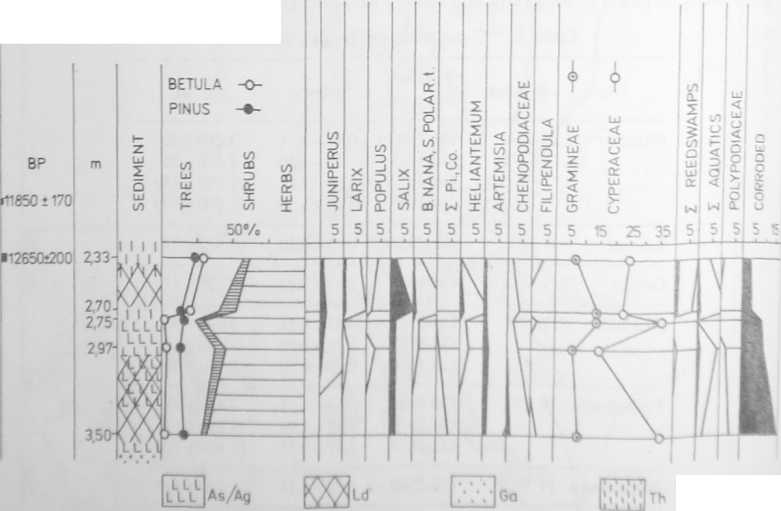DSC07955
66 D. Nalepka
Ag) and pen ty silts (Th, Ag) were analysed in both cores: a section, 1.20 m thick, from PI 17 every 30 cm and from PI 40, c. 0.40 m thick, every 2-7 cm.
A c. 50 cm core containing peats (Th), gyttja (Ld) and sand (Ga) with gyttja, clay and peat (Ld, As, Th) was taken from the peat bog Wielkie Błoto near Szarów (Lipka 1973; Nalepka 1989). This sediment (Pel 4) was analysed every 2 and 3 cm.
RADIOCARBON DATING
Ali of the profiles cited were dated by the radiocarbon method (Tab. 1). The datings were madę by M. F. Pazdur in the 14C Laboratory in Gliwice. At the present stage of palynological research, the 14C dates are the main ground for distinguishing the chronozones in the pollen diagrams and for their mutual correlations. Both 14C dates and palynological results do agree together. Only the datę of 11250±150 years BP (GD-4243) for the profile Pel 4 is too old when pompared with the palynological results because the dated materiał was taken at the boundary of different sediments. The datę of 9520 ± 110 years BP (GD-5055) for the profile Dr 10 refers to rebedded sediments.
DEVELOPMENT OF THE VEGETATION
THE B0LLING CHRONOZONE
This zonę is described on the basis of the whole diagram Pł 17 (Fig. 2) and of the deepest sample obtained from PI 86-1 (Fig. 3).
P0DŁEZ0WKA PŁ17

ANALONALEPK:'
Fig. 2. Simplificd pollen diagram from the Podfężówka 17 site
Pi-- Co - Picea + Corylus: AsiAg - Argilla steatodes or A. granosa; U - Limus detrituosus: Ga - Grana armoso . Th - Twk
herbacea
Wyszukiwarka
Podobne podstrony:
102 3.5.4 Apoptosis and celi cycle assay Adherent MSCs were cultured in 60-mm dishes in a-MEM supple
THE WORLD OF ISLAM. POLITICS AND $OCIF.TY / ŚWIAT ISLAMU. POLITYKA I SPOŁECZEŃSTWO M 2 $0(
UHAM083 66 ^ UNDERSTANDING HEADACHES AND M I G RAI N ES acupuncture have been shown to work for some
66 (47) 3. Mask and paint center and sides of table green, U* bcPlacemat Pillows For each pillow you
DSC07913 272 - Tufa deposits and some other sites reflect massive humid phase, tha
DSC07958 70 D. Nalepka 70 D. Nalepka ir- 8ETULA PINUS PŁ 40 PODŁEZOWKA ANALD NALEPKA
Doll Clothes 1 FashUłn-iype dolls, from tho top cKxkwi.sc. :irc wcariny gowns nutek; Ir* mii l*
00367 =71d7a8280d8fadbe63f01873c0973e 371Regret Indices and Capability Quantification the regret fu
img166 (3) 22 22 CN: Use a light blue for D, black for F, and gray for H. (1) Do n
więcej podobnych podstron